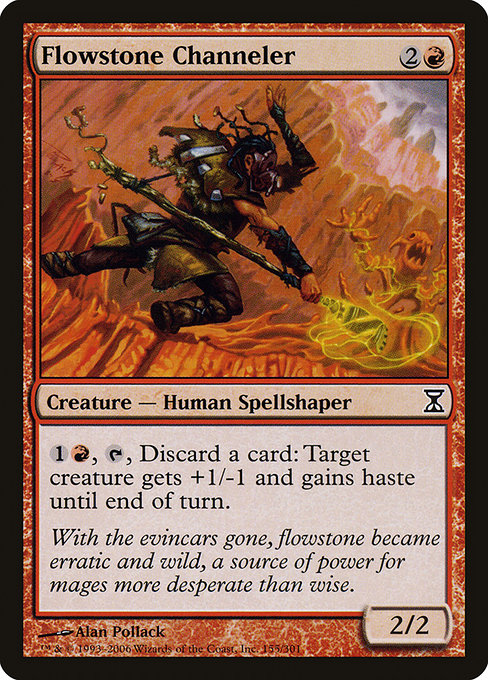
Image courtesy of Scryfall.com
Rarity as Signal: Flowstone Channeler and the Language of MTG Design
In the tapestry of Magic: The Gathering, rarity indicators act as more than decorative flourishes; they’re design signals that shape how players read a card the moment it comes into view. Flowstone Channeler, a red common from Time Spiral, is a perfect case study in how rarity language interacts with mana costs, creature type, and a compact, high-tempo play pattern. Priced for early-game pressure and built with an approachable {2}{R} mana cost, this 2/2 Spellshaper offers a crisp decision: you can trade cards for tempo, but you’re never guaranteed a rewarding outcome unless you read the board, discard wisely, and push through with haste. That’s the essence of red tempo in a single card 🧙🔥.
Flowstone Channeler showcases the classic MTG design habit of giving a deceptively simple body a surprisingly disruptive ability. Its cost of {2}{R} keeps it approachable in draft and constructed, while its activated ability—{1}{R}, {T}, Discard a card: Target creature gets +1/-1 and gains haste until end of turn—spurs a very specific risk-reward calculation. You’re spending a card from hand to propel a single creature into a burst of aggression, potentially turning a stalled board into a quick strike. The rarity indicator, a black-bordered common symbol on Time Spiral, whispers, “This is a card you can see repeatedly in a deck, but its impact hinges on precise timing and resource management.” The juxtaposition of common rarity with a potent, situational effect is a deliberate design choice that preserves accessibility while preserving meaningful strategic depth ⚔️.
“With the evincars gone, flowstone became erratic and wild, a source of power for mages more desperate than wise.”
The flavor text grounds Flowstone Channeler in a vivid lore moment from the Time Spiral era, a period famous for reimagining magic through time-warped themes and the consequences of power misused. This line paints the card’s world as volatile and hungry for speed—an atmosphere that complements red’s core identity. The art by Alan Pollack and the surrounding visuals reinforce that vibe: luminous veins of flowstone, crackling energy, and a figure who channels raw, unstable power. In terms of the design language of rarity, you can feel the set’s era even as you feel Flowstone Channeler’s push on the battlefield. The card’s non-foil print, and its foil variant, also serve to differentiate the tactile experience of rarity, reminding players that even “common” cards can carry a distinctive, collectible sheen 🎨.
From a gameplay perspective, the card thrives in environments where you’re willing to trade cards for tempo. The discard cost isn’t just a resource sink; it’s a lever you pull to reallocate momentum—turning a 2/2 creature into a temporary boost and haste engine. The effect interacts with discard strategies and card-filtering cards you might run in red decks, encouraging a thoughtful approach to hand composition. Flowstone Channeler invites players to think about tempo, risk, and reward in a way that’s both approachable for new players and satisfying for veterans who enjoy the mechanics of Spellshapers and red direct-damage archetypes 🧙🔥.
Beyond output, there’s a design joy in how the card communicates constraints. It teaches that not every powerful effect scales with pure card advantage; instead, the efficiency comes from choosing the right moment to flip a card and swing. That is the heart of MTG’s rarity storytelling: a common card can be a powerhouse in the right tempo window, while a rare gem may unlock broader synergies only when you’ve curated your hand and your mana base just so. Flowstone Channeler’s red-on-red flavor is a nostalgic nod to the era when players learned to manage burn, blockers, and the ever-fluctuating flowstone energy that the setting prescribes 🧙🔥💎.
As collectors and players alike weigh the value of time-twisted cards, Flowstone Channeler demonstrates how rarity indicators contribute to a card’s perceived and actual power. The card’s mana cost, body, and one-card discard mechanic create a compact identity that resonates with red’s risk-taking ethos. It’s a reminder that rarity isn’t merely about scarcity—it’s about how the card’s identity is read, built, and played across formats. The common status doesn’t dull its personality; it amplifies its accessibility and invites a broader set of players to experiment with tempo, discard, and quick-strike tactics 🧙🔥⚔️.
For players who enjoy curating a personal MTG ecosystem, this is a card that benefits from careful sleeve and case care. And speaking of care, the way you transport and protect your favorite decks—especially when you’re carrying a Time Spiral-era staple—matters as much as the decisions you make on the board. If you’re looking to keep your Flowstone Channeler cards looking sharp while you plot your next blitz, consider a protective home that fits your lifestyle. The modern MagSafe-compatible, polycarbonate card holder shown in the linked product is a smart companion for tournament days and casual shop sessions alike, marrying durability with the portability every drafthound adores 🧩.
Polycarbonate Card Holder Phone Case with MagSafeMore from our network
- https://blog.digital-vault.xyz/blog/post/top-reddit-threads-on-arms-of-hadar-decks-and-tactics/
- https://transparent-paper.shop/blog/post/streamline-digital-product-delivery-with-automation/
- https://blog.digital-vault.xyz/blog/post/how-to-run-community-surveys-that-yield-actionable-insights/
- https://crypto-acolytes.xyz/blog/post/hot-blue-giant-at-15-kpc-illuminates-milky-way-anew/
- https://crypto-acolytes.xyz/blog/post/gamers-power-crypto-charities-a-new-era-of-giving/